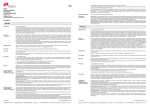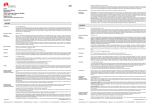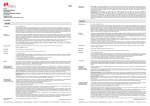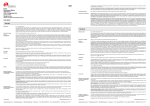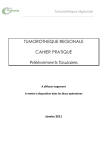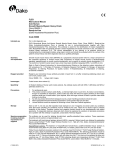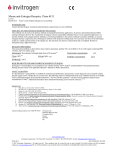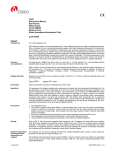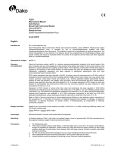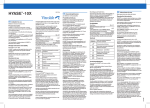Download Monoclonal Mouse
Transcript
FLEX Monoclonal Mouse Anti-Human Caldesmon Clone h-CD Ready-to-Use (Dako Autostainer/Autostainer Plus) Code IS054 English Intended use For in vitro diagnostic use. FLEX Monoclonal Mouse Anti-Human Caldesmon, Clone h-CD, Ready-to-Use, (Dako Autostainer/Autostainer Plus), is intended for use in immunohistochemistry with Dako Autostainer/Autostainer Plus instruments. This antibody is useful for the identification of tumors with smooth muscle cell differentiation (1-2). The clinical interpretation of any staining or its absence should be complemented by morphological studies using proper controls and should be evaluated within the context of the patient's clinical history and other diagnostic tests by a qualified pathologist. Summary and explanation Caldesmon is a developmentally regulated protein involved in smooth muscle and non-muscle contraction (3,4). Refer to Dako’s General Instructions for Immunohistochemical Staining or the detection system instructions of IHC procedures for: 1) Principle of Procedure, 2) Materials Required, Not Supplied, 3) Storage, 4) Specimen Preparation, 5) Staining Procedure, 6) Quality Control, 7) Troubleshooting, 8) Interpretation of Staining, 9) General Limitations. Reagent provided Ready-to-use monoclonal mouse antibody provided in liquid form in a buffer containing stabilizing protein and 0.015 mol/L NaN3. Clone: h-CD Isotype: IgG1, kappa Immunogen Crude human uterus extract (1) Specificity Two closely related variants of human caldesmon have been identified which differ in their electrophoretic mobility and cellular distribution. The h-caldesmon variant (120–150 kDa) is predominantly expressed in smooth muscle whereas I-caldesmon (70–80 kDa) is found in non-muscle tissue and cells. Neither of the two variants have been detected in skeletal muscle (3). Monoclonal anti-caldesmon, h-CD, recognizes only the 150 kDa variant (h-caldesmon) in Western blots of human aortic media extracts and is unreactive with fibroblast extracts from cultivated human foreskin (1). Precautions 1. For professional users. 2. This product contains sodium azide (NaN3), a chemical highly toxic in pure form. At product concentrations, though not classified as hazardous, sodium azide may react with lead and copper plumbing to form highly explosive build-ups of metal azides. Upon disposal, flush with large volumes of water to prevent metal azide build-up in plumbing. 3. As with any product derived from biological sources, proper handling procedures should be used. 4. Wear appropriate Personal Protective Equipment to avoid contact with eyes and skin. 5. Unused solution should be disposed of according to local, State and Federal regulations. Storage Store at 2-8 °C. Do not use after expiration date stamped on vial. If reagents are stored under any conditions other than those specified, the conditions must be verified by the user. There are no obvious signs to indicate instability of this product. Therefore, positive and negative controls should be run simultaneously with patient specimens. If unexpected staining is observed which cannot be explained by variations in laboratory procedures and a problem with the antibody is suspected, contact Dako Technical Support. Specimen preparation including materials required but not supplied The antibody can be used for labeling formalin-fixed, paraffin-embedded tissue sections. Tissue specimens should be cut into sections of approximately 4 µm. Pre-treatment with heat-induced epitope retrieval (HIER) is required. Optimal results are obtained by pretreating tissues using EnVision FLEX Target Retrieval Solution, High pH (10x) (Dako Autostainer/Autostainer Plus) (Code K8012/K8014). Deparaffinized sections: Pre-treatment of deparaffinized formalin-fixed, paraffin-embedded tissue sections is recommended using Dako PT Link (Code PT100/PT101). For details, please refer to the PT Link User Guide. Follow the pre-treatment procedure outlined in the package Insert for EnVision FLEX Target Retrieval Solution, High pH (10x) (Dako Autostainer/Autostainer Plus) (Code K8012/K8014). The following parameters should be (115739-001) 307124EFG_001 p. 1/7 used for PT Link: Pre-heat temperature: 65 °C; epitope retrieval temperature and time: 97 °C for 20 (±1) minutes; cool down to 65 °C. Rinse sections with diluted room temperature EnVision FLEX Wash Buffer (10x) (Dako Autostainer/Autostainer Plus) (Code K8012). Paraffin-embedded sections: As alternative specimen preparation, both deparaffinization and epitope retrieval can be performed in the PT Link using a modified procedure. See the PT Link User Guide for instructions. After the staining procedure has been completed, the sections must be dehydrated, cleared and mounted using permanent mounting medium. The tissue sections should not dry out during the treatment or during the following immunohistochemical staining procedure. For greater adherence of tissue sections to glass slides, the use of Dako Silanized Slides (Code S3003) is recommended. Staining procedure including materials required but not supplied The recommended visualization system is EnVision FLEX+, Mouse High pH (Dako Autostainer/Autostainer Plus) (Code K8012). The staining steps and incubation times are pre-programmed into the software of Dako Autostainer/Autostainer Plus instruments, using the following protocols: Template protocol: FLEXRTU2 (200 uL dispense volume) or FLEXRTU3 (300 uL dispense volume) Autoprogram (without counterstaining): CALD or Autoprogram (with counterstaining): CALDH The Auxiliary step should be set to “rinse buffer” in staining runs with ≤10 slides. For staining runs with >10 slides the Auxiliary step should be set to “none.” This ascertains comparable wash times. All incubation steps should be performed at room temperature. For details, please refer to the Operator’s Manual for the dedicated instrument. If the protocols are not available on the used Dako Autostainer instrument, please contact Dako Technical Services. Optimal conditions may vary depending on specimen and preparation methods, and should be determined by each individual laboratory. If the evaluating pathologist should desire a different staining intensity, a Dako Application Specialist/Technical Service Specialist can be contacted for information on re-programming of the protocol. Verify that the performance of the adjusted protocol is still valid by evaluating that the staining pattern is identical to the staining pattern described in “Performance characteristics.” Counterstaining in hematoxylin is recommended using EnVision FLEX Hematoxylin (Dako Autostainer/Autostainer Plus) (Code K8018). Non-aqueous, permanent mounting medium is recommended. Positive and negative controls should be run simultaneously using the same protocol as the patient specimens. The positive control tissue should include smooth muscle cells and the cells/structures should display reaction patterns as described for this tissue in “Performance characteristics” in all positive specimens. The recommended negative control reagent is FLEX Negative Control, Mouse (Dako Autostainer/Autostainer Plus) (Code IS750). Staining interpretation The cellular staining pattern is cytoplasmic. Performance characteristics Normal tissues: Monoclonal anti-caldesmon was found to localize h-caldesmon in cryostat sections of human tissues including developing visceral smooth muscle from 10–20 week-old fetal trachea, esophagus, jejunum and uterus. Aortic smooth muscle cells from 10 and 20 week-old fetuses were unreactive with anti-caldesmon (1). In the adult, caldesmon expression was demonstrated in vascular and visceral smooth muscle cells but not epithelial cells, endothelial cells or connective tissue fibroblasts. Cells of the tunica media and a subpopulation of smooth muscle cells of the sub-endothelial intima of the adult aorta were shown to stain positively with anti-caldesmon (1). In immunohistochemical (IHC) studies on cryostat sections of normal human breast, monoclonal anti-caldesmon labeled the smooth muscle cells of blood vessels and a subset of myoepithelial cells in the galactophorous sinuses. Myoepithelial cells of the lobules, ducts and luminal epithelial cells of normal breast did not react positively (5). Abnormal tissues: In IHC studies on breast carcinoma, monoclonal anti-caldesmon has been demonstrated to label a subpopulation of myoepithelial cells but is unreactive with myofibroblasts and tumor cells (6). This antibody is also used to identify tumors with smooth muscle cell differentiation such as leiomyomas, angioleiomyomas, leiomyosarcomas, eight rhabdomyosarcomas, malignant fibrous histiocytomas, desmoids, and glomus tumors (2). (115739-001) 307124EFG_001 p. 2/7 Français Réf. IS054 Utilisation prévue Pour utilisation diagnostique in vitro. FLEX Monoclonal Mouse Anti-Human Caldesmon, clone h-CD, Ready-to-Use, (Dako Autostainer/Autostainer Plus), est destiné à une utilisation en immunohistochimie avec les instruments Dako Autostainer/Autostainer Plus. Cet anticorps est utile pour l’identification de tumeurs avec une différenciation sur les cellules des muscles lisses (1-2). L’interprétation clinique de toute coloration ou son absence doit être complétée par des études morphologiques en utilisant des contrôles appropriés et doit être évaluée en fonction des antécédents cliniques du patient et d’autres tests diagnostiques par un pathologiste qualifié. Résumé et explication La caldesmone est une protéine dont le développement est régulé et qui est impliquée dans les contractions des muscles lisses et des contractions non musculaires (3,4). Se référer aux Instructions générales de coloration immunohistochimique de Dako ou aux instructions du système de détection relatives aux procédures IHC pour plus d’informations concernant les points suivants : 1) Principe de procédure, 2) Matériels requis mais non fournis, 3) Conservation, 4) Préparation des échantillons, 5) Procédure de coloration, 6) Contrôle qualité, 7) Dépannage, 8) Interprétation de la coloration, 9) Limites générales. Réactifs fournis Anticorps monoclonal de souris prêt à l’emploi fourni sous forme liquide dans un tampon contenant une protéine stabilisante et 0,015 mol/L d’azide de sodium. Clone : h-CD Isotype : IgG1, kappa Immunogène Extrait brut d’utérus humain (1) Spécificité Deux variants très proches de la caldesmone humaine ont été identifiés qui diffèrent par leur mobilité électrophorétique et leur répartition cellulaire. Le variant h-caldesmone (120–150 kDa) est exprimé essentiellement dans le muscle lisse tandis que le i-caldesmone (70–80 kDa) est présent dans les tissus et les cellules non musculaires. Aucun des deux variants n’a été détecté dans le muscle squelettique (3). Monoclonal anti-caldesmon, h-CD, reconnaît uniquement le variant de 150 kDa (h-caldesmone) dans les analyses par Western blot d’extraits de média aortique humaine et ne réagit pas aux extraits de fibroblastes issus de prépuce humain mis en culture (1). Précautions 1. Pour utilisateurs professionnels. 2. Ce produit contient de l’azide de sodium (NaN3), produit chimique hautement toxique dans sa forme pure. Aux concentrations du produit, bien que non classé comme dangereux, l’azide de sodium peut réagir avec le cuivre et le plomb des canalisations et former des accumulations d’azides métalliques hautement explosifs. Lors de l’élimination, rincer abondamment à l’eau pour éviter toute accumulation d’azide métallique dans les canalisations. 3. Comme avec tout produit d’origine biologique, des procédures de manipulation appropriées doivent être respectées. 4. Porter un vêtement de protection approprié pour éviter le contact avec les yeux et la peau. 5. Les solutions non utilisées doivent être éliminées conformément aux réglementations locales et nationales. Conservation Conserver entre 2 et 8 °C. Ne pas utiliser après la date de péremption imprimée sur le flacon. Si les réactifs sont conservés dans des conditions autres que celles indiquées, celles-ci doivent être validées par l’utilisateur. Il n’y a aucun signe évident indiquant l’instabilité de ce produit. Par conséquent, des contrôles positifs et négatifs doivent être testés en même temps que les échantillons de patient. Si une coloration inattendue est observée, qui ne peut être expliquée par un changement des procédures du laboratoire, et en cas de suspicion d’un problème lié à l’anticorps, contacter l’assistance technique de Dako. Préparation des échantillons y compris le matériel requis mais non fourni L’anticorps peut être utilisé pour le marquage des coupes de tissus inclus en paraffine et fixés au formol. L'épaisseur des coupes d'échantillons de tissu doit être d’environ 4 µm. Le prétraitement avec un démasquage d’épitope induit par la chaleur (HIER) est nécessaire. Des résultats optimaux sont obtenus en prétraitant les tissus à l’aide de la EnVision FLEX Target Retrieval Solution, High pH (10x), (Dako Autostainer/Autostainer Plus) (Réf. K8012/K8014). Coupes déparaffinées : Le pré-traitement des coupes de tissus déparaffinés fixés au formol et inclus en paraffine est recommandé à l’aide du Dako PT Link (Réf. PT100/PT101). Pour plus de détails, se référer au Guide d’utilisation du PT Link. Suivre la procédure de pré-traitement indiquée dans la notice pour la EnVision FLEX Target Retrieval Solution, High pH (10x), (Dako Autostainer/Autostainer Plus) (Réf. K8012/K8014). Les paramètres suivants doivent être utilisés pour le PT Link : Température de préchauffage : 65 °C; température et durée de restauration de l’épitope : 97 °C pour 20 (±1) minutes ; laisser refroidir jusqu’à 65 °C. Rincer les coupes avec un EnVision FLEX Wash Buffer (10x), dilué à température ambiante (Dako Autostainer/Autostainer Plus) (Réf. K8012). (115739-001) 307124EFG_001 p. 3/7 Coupes incluses en paraffine : Comme préparation alternative des échantillons, le déparaffinage et la restauration de l’épitope peuvent être réalisés dans le PT Link à l’aide d’une procédure modifiée. Se référer aux instructions du Guide d’utilisation du PT Link. Une fois que la procédure de coloration est terminée, les coupes doivent être déshydratées, lavées et montées à l’aide d’un milieu de montage permanent. Les coupes de tissus ne doivent pas sécher lors du traitement ou lors de la procédure de coloration immunohistochimique suivante. Pour une meilleure adhérence des coupes de tissus sur les lames de verre, il est recommandé d’utiliser des lames Dako Silanized Slides (Réf. S3003). Procédure de coloration y compris le matériel requis mais non fourni Le système de visualisation recommandé est le EnVision FLEX+, Mouse High pH (Dako Autostainer/Autostainer Plus) (Réf. K8012). Les étapes de coloration et d’incubation sont préprogrammées dans le logiciel des instruments Dako Autostainer/Autostainer Plus, à l’aide des protocoles suivants : Protocole modèle : FLEXRTU2 (volume de distribution de 200 µl) ou FLEXRTU3 (volume de distribution de 300 µl) Autoprogram (sans contre-coloration) : CALD ou Autoprogram (avec contre-coloration) : CALDH L’étape Auxiliary doit être réglée sur « rinse buffer » lors des cycles de coloration avec ≤10 lames. Pour les cycles de coloration de >10 lames, l’étape Auxiliary doit être réglée sur « none ». Cela confirme des temps de lavage comparables. Toutes les étapes d’incubation doivent être effectuées à température ambiante. Pour plus de détails, se référer au Manuel de l’opérateur spécifique à l'instrument. Si les protocoles ne sont pas disponibles sur l’instrument Dako Autostainer utilisé, contacter le service technique de Dako. Les conditions optimales peuvent varier en fonction du prélèvement et des méthodes de préparation, et doivent être déterminées par chaque laboratoire individuellement. Si le pathologiste qui réalise l’évaluation désire une intensité de coloration différente, un spécialiste d’application/spécialiste du service technique de Dako peut être contacté pour obtenir des informations sur la re-programmation du protocole. Vérifier que l'exécution du protocole modifié est toujours valide en vérifiant que le schéma de coloration est identique au schéma de coloration décrit dans les « Caractéristiques de performance ». Il est recommandé d’effectuer une contre-coloration à l’aide d’hématoxyline EnVision FLEX Hematoxylin, (Dako Autostainer/Autostainer Plus) (Réf. K8018). L’utilisation d’un milieu de montage permanent non aqueux est recommandée. Des contrôles positifs et négatifs doivent être réalisés en même temps et avec le même protocole que les échantillons du patient. Le contrôle de tissu positif doit comprendre les cellules de muscle lisse et les cellules/structures doivent présenter des schémas de réaction tels que décrits pour ces tissus dans les « Caractéristiques de performance » pour tous les échantillons positifs. Le contrôle négatif recommandé est le FLEX Negative Control, Mouse, (Dako Autostainer/Autostainer Plus) (Réf. IS750). Interprétation de la coloration Le schéma de coloration cellulaire est cytoplasmique. Caractéristiques de performance Tissus sains : L’anticorps monoclonal anti-caldesmone a détecté le variant h-caldesmone dans des coupes cryostat de tissus humains, incluant le muscle lisse viscéral en développement de la trachée, du jéjunum, de l’œsophage et de l’utérus de fœtus âgé de 10 à 20 semaines. Les cellules de muscle lisse aortique de fœtus âgés de 10 et 20 semaines n’ont pas réagi à l’anti-caldesmone (1). Chez l’adulte, la caldesmone a été exprimée dans les cellules du muscle lisse viscéral et vasculaire mais pas dans les cellules épithéliales, les cellules endothéliales ou les fibroblastes du tissu conjonctif. Les cellules de la média et une sous-population de cellules de muscle lisse de l'intima sous-endothéliale de l'aorte adulte ont été marquées positivement par l’anticorps anti-caldesmone (1). Dans les analyses immunohistochimiques (IHC) de coupes cryostat de sein humain sain, l'anticorps monoclonal anti-caldesmone a marqué les cellules de muscle lisse des vaisseaux sanguins et un sous-ensemble de cellules myoépithéliales dans les sinus galactophores. Les cellules myoépithéliales des lobules, de canaux et les cellules épithéliales luminales du sein normal n’ont pas réagi positivement (5). Tissus tumoraux : Dans les analyses IHC de cancer du sein, l'anticorps monoclonal anti-caldesmone marque une sous-population de cellules myoépithéliales mais il ne réagit pas aux myofibroblastes et aux cellules tumorales (6). Cet anticorps est également utilisé pour identifier les tumeurs avec une différenciation du muscle lisse telle que les léiomyomes, les angioléiomyomes, les léiomyosarcomes, huit rhabdomyosarcomes, les histiocytomes fibreux bénins, les tumeurs desmoïdes et glomiques (2). (115739-001) 307124EFG_001 p. 4/7 Deutsch Code-Nr. IS054 Zweckbestimmung Zur In-vitro-Diagnostik. FLEX Monoclonal Mouse Anti-Human Caldesmon, Clone h-CD, Ready-to-Use, (Dako Autostainer/Autostainer Plus) ist zur Verwendung in der Immunhistochemie in Verbindung mit Dako Autostainer/Autostainer Plus-Geräten bestimmt. Dieser Antikörper dient zur Identifizierung von Tumoren mit einer Differenzierung bei Zellen der glatten Muskulatur (1–2). Die klinische Auswertung einer eventuell eintretenden Färbung sollte durch morphologische Studien mit ordnungsgemäßen Kontrollen ergänzt werden und von einem qualifizierten Pathologen unter Berücksichtigung der Krankengeschichte und anderer Diagnostiktests des Patienten vorgenommen werden. Zusammenfassung und Erklärung Caldesmon ist ein an der Glattmuskel- und nicht-muskulären Kontraktion beteiligtes entwicklungsreguliertes Protein (3,4). Folgende Angaben bitte den Allgemeinen Richtlinien zur immunhistochemischen Färbung von Dako oder den Anweisungen des Detektionssystems für IHC-Verfahren entnehmen: 1) Verfahrensprinzip, 2) Erforderliche, aber nicht mitgelieferte Materialien, 3) Aufbewahrung, 4) Vorbereitung der Probe, 5) Färbeverfahren, 6) Qualitätskontrolle, 7) Fehlersuche und -behebung, 8) Auswertung der Färbung, 9) Allgemeine Beschränkungen. Geliefertes Reagenz Gebrauchsfertiger, monoklonaler Maus-Antikörper in flüssiger Form in einem Puffer, der stabilisierendes Protein und 0,015 mol/L NaN3 enthält. Klon: h-CD Isotyp: IgG1, Kappa Immunogen Rohextrakt aus menschlichem Uterus (1) Spezifität Zwei eng verwandte Varianten des menschlichen Caldesmon wurden identifiziert, die sich in ihrer elektrophoretischen Mobilität und zellulären Verteilung unterscheiden. Die h-Caldesmon-Variante (120–150 kDa) wird hauptsächlich in glatten Muskelzellen nachgewiesen, wohingegen I-Caldesmon (70–80 kDa) in nichtmuskulärem Gewebe und nicht-muskulären Zellen vorkommt. Keine der beiden Varianten wurde in der Skelettmuskulatur nachgewiesen (3). Monoclonal anti-caldesmon, h-CD erkennt nur die 150-kDa-Variante (h-Caldesmon) in Western-Blots menschlicher Aorten-Medienextrakte und ist unreaktiv mit Fibroblastextrakten kultivierter menschlicher Vorhaut (1). Vorsichtsmaßnahmen 1. Nur für Fachpersonal bestimmt. 2. Dieses Produkt enthält Natriumazid (NaN3), eine in reiner Form äußerst giftige Chemikalie. Natriumazid kann auch in als ungefährlich eingestuften Konzentrationen mit Blei- und Kupferrohren reagieren und hochexplosive Metallazide bilden. Nach der Entsorgung stets mit viel Wasser nachspülen, um Metallazidansammlungen in den Leitungen vorzubeugen. 3. Wie alle Produkte biologischen Ursprungs müssen auch diese entsprechend gehandhabt werden. 4. Geeignete Schutzkleidung tragen, um Augen- und Hautkontakt zu vermeiden. 5. Nicht verwendete Lösung ist entsprechend örtlichen, bundesstaatlichen und staatlichen Richtlinien zu entsorgen. Lagerung Bei 2–8 °C aufbewahren. Nach Ablauf des auf dem Fläschchen aufgedruckten Verfalldatums nicht mehr verwenden. Werden die Reagenzien unter anderen als den angegebenen Bedingungen aufbewahrt, müssen diese Bedingungen vom Benutzer validiert werden. Es gibt keine offensichtlichen Anzeichen für eine eventuelle Produktinstabilität. Positiv- und Negativkontrollen sollten daher zur gleichen Zeit wie die Patientenproben getestet werden. Falls es zu einer unerwarteten Färbung kommt, die sich nicht durch Unterschiede bei Laborverfahren erklären lässt und auf ein Problem mit dem Antikörper hindeutet, ist der technische Kundendienst von Dako zu verständigen. Vorbereitung der Probe und erforderliche, aber nicht mitgelieferte Materialien Der Antikörper eignet sich zur Markierung von formalinfixierten und paraffineingebetteten Gewebeschnitten. Gewebeproben sollten in Schnitte von ca. 4 µm Stärke geschnitten werden. Die Vorbehandlung durch hitzeinduzierte Epitopdemaskierung (HIER) ist erforderlich. Optimale Ergebnisse können durch Vorbehandlung der Gewebe mit EnVision™ FLEX Target Retrieval Solution, High pH (10x), (Dako Autostainer/Autostainer Plus) (Code-Nr. K8012/K8014) erzielt werden. Entparaffinierte Schnitte: Die Vorbehandlung der entparaffinierten, formalinfixierten, paraffineingebetteten Gewebeschnitte sollte mit Dako PT Link (Code-Nr. PT100/PT101) erfolgen. Weitere Informationen hierzu siehe PT Link-Benutzerhandbuch. Vorbehandlung gemäß der Beschreibung in der Packungsbeilage für EnVision™ FLEX Target Retrieval Solution, High pH (10x) (Dako Autostainer/Autostainer Plus) (Code-Nr. K8012/K8014) durchführen. Für PT Link sollten die folgenden Parameter verwendet werden: Vorwärmtemperatur: 65 °C; Temperatur und Zeit für Epitopdemaskierung: 97 °C für 20 (±1) Minuten; auf 65 °C abkühlen lassen. Schnitte mit auf Raumtemperatur gebrachtem, verdünntem EnVision™ FLEX Wash Buffer (10x) (Dako Autostainer/Autostainer Plus) (Code-Nr. K8012) abspülen. (115739-001) 307124EFG_001 p. 5/7 Paraffineingebettete Schnitte: Zur Probenpräparation kann für Entparaffinierung und Epitopdemaskierung im PT Link auch ein modifiziertes Verfahren verwendet werden. Weitere Informationen siehe PT LinkBenutzerhandbuch. Nach Abschluss des Färbeverfahrens müssen die Schnitte dehydriert, geklärt und unter Verwendung eines permanenten Fixiermittels auf die Objektträger aufgebracht werden. Die Gewebeschnitte dürfen während der Behandlung oder während des anschließenden immunhistochemischen Färbeverfahrens nicht austrocknen. Zur besseren Haftung der Gewebeschnitte an den Glasobjektträgern wird die Verwendung von Dako Silanized Slides (Code-Nr. S3003) empfohlen. Färbeverfahren und erforderliche, aber nicht mitgelieferte Materialien Das empfohlene Visualisierungssystem ist EnVision™ FLEX+, Mouse High pH (Dako Autostainer/Autostainer Plus) (Code-Nr. K8012). Die Färbeschritte und Inkubationszeiten sind in der Software der Dako Autostainer/Autostainer Plus-Geräte mit den folgenden Protokollen vorprogrammiert: Matrix-Protokoll: FLEXRTU2 (200 µl Abgabevolumen) oder FLEXRTU3 (300 µl Abgabevolumen) Autoprogram (ohne Gegenfärbung): CALD oder Autoprogram (mit Gegenfärbung): CALDH Bei Färbedurchläufen mit höchstens 10 Objektträgern sollte der „Zusatz“-Schritt auf „Pufferspülgang“ eingestellt werden. Für Färbedurchläufe mit mehr als 10 Objektträgern den „Zusatz“-Schritt auf „Keine“ einstellen. Dies gewährleistet vergleichbare Waschzeiten. Alle Inkubationsschritte sollten bei Raumtemperatur durchgeführt werden. Nähere Einzelheiten bitte dem Benutzerhandbuch für das jeweilige Gerät entnehmen. Wenn die Färbeprotokolle auf dem verwendeten Dako Autostainer-Gerät nicht verfügbar sind, bitte den Technischen Kundendienst von Dako verständigen. Optimale Bedingungen können je nach Probe und Präparationsverfahren unterschiedlich sein und sollten vom jeweiligen Labor selbst ermittelt werden. Falls der beurteilende Pathologe eine andere Färbungsintensität wünscht, kann ein Anwendungsspezialist oder Kundendiensttechniker von Dako bei der Neuprogrammierung des Protokolls helfen. Die Leistung des angepassten Protokolls muss verifiziert werden, indem gewährleistet wird, dass das Färbemuster mit dem unter „Leistungsmerkmale“ beschriebenen Färbemuster identisch ist. Die Gegenfärbung in Hämatoxylin sollte mit EnVision™ FLEX Hematoxylin (Dako Autostainer/Autostainer Plus) (Code-Nr. K8018) ausgeführt werden. Empfohlen wird ein nichtwässriges, permanentes Fixiermittel. Positiv- und Negativkontrollen sollten zur gleichen Zeit und mit demselben Protokoll wie die Patientenproben getestet werden. Das positive Kontrollgewebe sollte Zellen der glatten Muskulatur enthalten und die Zellen/Strukturen müssen in allen positiven Proben die für dieses Gewebe unter „Leistungsmerkmale“ beschriebenen Reaktionsmuster aufweisen. Das empfohlene Negativ-Kontrollreagenz ist FLEX Negative Control, Mouse, (Dako Autostainer/Autostainer Plus) (Code-Nr. IS750). Auswertung der Färbung Das zelluläre Färbemuster ist zytoplasmatisch. Leistungsmerkmale Gesundes Gewebe: Es wurde nachgewiesen, dass monoklonales Anti-Caldesmon in Gefrierschnitten von menschlichem Gewebe h-Caldesmon lokalisiert, einschließlich sich entwickelnder, glatter Viszeralmuskulatur von 10–20 Wochen altem fötalen Trachea-, Speiseröhren-, Jejunum- und Uterusgewebe. Glatte Muskelzellen der Aorta von 10 und 20 Wochen alten Föten zeigten keine Reaktion mit Anti-Caldesmon (1). Bei Erwachsenen wurde Caldesmon in Zellen glatter Vaskulär- und Viszeralmuskulatur, aber nicht in Epithelzellen, Endothelzellen oder Bindegewebsfibroblasten nachgewiesen. Bei Zellen der „Tunica media“ und einer Subpopulation glatter Muskelzellen der subendothelen Intima der adulten Aorta wurde eine positive Färbung mit Anti-Caldesmon nachgewiesen (1). In immunhistochemischen (IHC) Studien zu Gefrierschnitten von gesundem menschlichem Brustgewebe konnte monoklonales Anti-Caldesmon die glatten Muskelzellen von Blutgefäßen und einer Teilmenge von Myoepithelzellen der Milchsäckchen markieren. Myoepithelzellen der Lobuli, Gänge und luminalen Epithelzellen gesunden Brustgewebes reagierten nicht positiv (5). Pathologisches Gewebe: In IHC-Studien zu Brustkarzinomen konnte monoklonales Anti-Caldesmon eine Subpopulation von Myoepithelzellen markieren, ist aber unreaktiv mit Myofibroblasten und Tumorzellen (6). Dieser Antikörper wird auch dazu verwendet, Tumore mit einer Differenzierung glatter Muskelzellen, wie z. B. Leiomyome, Angioleiomyome, Leiomyosarkome, acht Rhabdomyosarkome, maligne fibröse Histiozytome, Desmoide und Glomustumore, zu identifizieren (2). References Bibliographie Literaturangaben (115739-001) 1. Frid MG, et al. Phenotypic changes of human smooth muscle cells during development: Late expression of heavy caldesmon and calponin. Dev Biol 1992; 153:185 2. Watanabe K, et al. h-Caldesmon in leiomyosarcoma and tumors with smooth muscle cell-like differentiation: its specific expression in the smooth muscle cell tumor, Hum Pathol 1999, 30:392-396 3. Sobue K and Sellers JR. Caldesmon, a novel regulatory protein in smooth muscle and nonmuscle actomyosin systems. J Biol Chem 1991; 266(19):12115 4. Glukhova MA, et al. Developmental changes in expression of contractile and cytoskeletal proteins in human aortic smooth muscle. J Biol Chem 1990; 265(22):13042 5. Lazard D, et al. Expression of smooth muscle-specific proteins in myoepithelium and stromal myofibroblasts of normal and malignant human breast tissue. Proc Natl Acad Sci USA 1993; 90:999 6. Wang NP, et al. Monoclonal antibodies (MAbs) to novel myoepithelium-associated proteins can distinguish between benign and malignant lesions of the breast. US Canad Acad Pathol Abstr 1996; 26A:135 307124EFG_001 p. 6/7 Edition 09/07 (115739-001) 307124EFG_001 p. 7/7







